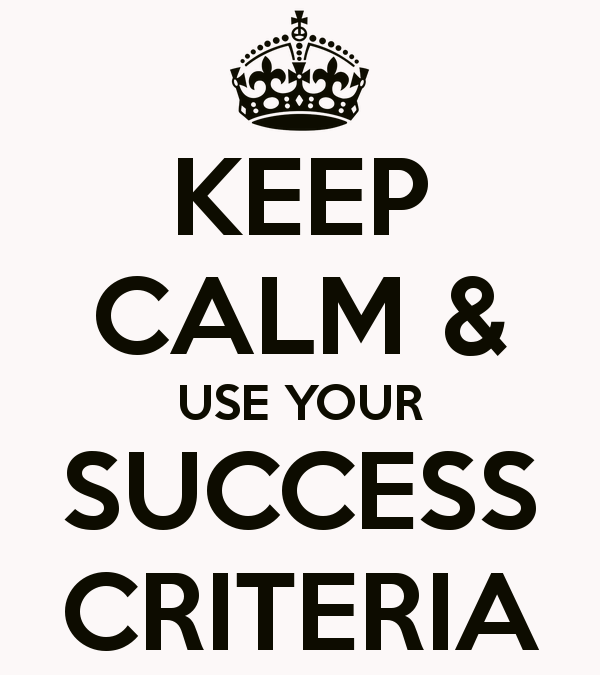Before you start planning your strategy (or project ), you have to do one very important step first: identify what the success criteria are going to be.
Unfortunately many people skip this step. And that is a mistake – for several reasons:
- You want all decision makers to agree on what success is going to look like
- All activities in your plan must support these success criteria
- Progress towards success needs to be measured to build support and momentum
A Cautionary Tale
Many years ago we were part of a project involving a major bank. This large commercial bank was considering taking over the retail operations of a government operated postal delivery business.
Our role was to develop a change management plan as part of an overall business strategy. Therefor we went ahead and did our usual stakeholder analysis and developed what we felt was a good strategic plan. Finally, after three months we were ready for approval to begin implementing.
 Imagine our surprise when, just at that point, one of the key government ministers vehemently opposed the entire strategy! Ultimately we had to scrap the project. Talk about a heart breaking and embarrassing outcome!
Imagine our surprise when, just at that point, one of the key government ministers vehemently opposed the entire strategy! Ultimately we had to scrap the project. Talk about a heart breaking and embarrassing outcome!
So what happened? Quite simply, we did not get agreement on what success would look like for everyone.
For instance, we felt we understood the objective. Plus we knew key decision makers in both organizations developed and championed the objective. Unfortunately, our sponsors’ objectives and this minister’s vision of success were vastly different. And we were caught in the middle. Honestly, we felt like a piece of paper between two powerful scissor blades.
Get Agreement on “The Look and Feel of Success”
Looking back at this from the perspective of meeting success objectives, here is what success looked like for the key stakeholders.
Success for the bank executives was enlarging their retail banking operations. Success for the postal service management was reducing a very expensive retail footprint and labour costs. For us, success was quite simply getting this lucrative contract. Finally, for the minister, success was having a strong visual brand of the government in action, and protection for unionized jobs.
As a result, our strategic plan accomplished three of the four. For the bank, postal service, us, and the minister it looked like this: was win-win-win-…lose. Since the minister was a high ranking elected official he was never going to lose. So, ultimately it became: lose-lose-lose-win!
Being successful means meeting expectations of ALL key decision makers.
It was a lesson I personally never forgot. Now we do not proceed with planning unless all of the key decision makers agree, as a group, on what the success factors are going to be and how they would be measured. Sometimes enforcing this step has caused tension, but we have never had any more regrets.
Activities should support success criteria
 All roads SHOULD lead to Rome.
All roads SHOULD lead to Rome.
Ask yourself when you are planning an activity: “Does that activity support one of our success metrics?” In other words, does this activity contribute to the success of the project? If the answer is not an absolute “yes”, you have to ask yourself why you are even considering it.
Measuring progress
Everyone is likely familiar with the statement, “what gets measured gets done.” Quite simply, if you do not define what success looks like at the beginning, how will you know that you are getting there? And how will you know that you have arrived?
Success needs to be visible in peoples’ minds. Decision makers have to determine what this will actually “look like” for their business. Basically, your key stakeholders need to be able to picture it. Measurements make vague statements visible. And that means that getting agreement on these tangible outcomes sets you on a solid path to success.
Most strategic projects go through what is sometimes known semi-jokingly as “the pit of despair”. It’s that phase where everyone is busy grinding it out with seemingly little to show for it. With success measures in place you can help everyone through this stage, and boost morale, by highlighting progress toward these measurements.
What you can do now
If you are in the process of planning your strategic project, take a moment to review whether you have success criteria, and whether they are measurable. Then, check during your next team meeting whether all of you agree on these. You may be surprised.
 If you are in the middle of your project and haven’t done this, it’s never too late. You can always insert an agenda item in your next meeting to define, and align on, the picture of success you are all aiming for. Some new tasks may come out of it, but you may also be pleasantly rewarded as some activities fall away.
If you are in the middle of your project and haven’t done this, it’s never too late. You can always insert an agenda item in your next meeting to define, and align on, the picture of success you are all aiming for. Some new tasks may come out of it, but you may also be pleasantly rewarded as some activities fall away.
Enjoy your journey!












